 |
 All Classic Ads Vintage Collection - Volkswagen related ads All Classic Ads Vintage Collection - Volkswagen related ads
|
|
History of Volkswagen (1933)
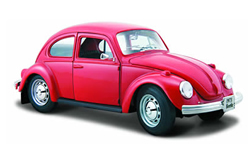 Literally, the word "volkswagen" means "people's car." In Germany, the idea of a people's car wasn't exactly a new one. Before the 1930's, there had been many efforts to create simple cars that everyone could afford, but none met with profound success. Almost all cars before 1930, even if they were designed to be simple enough for the average person, ended up costing more than the average worker's yearly wage. Literally, the word "volkswagen" means "people's car." In Germany, the idea of a people's car wasn't exactly a new one. Before the 1930's, there had been many efforts to create simple cars that everyone could afford, but none met with profound success. Almost all cars before 1930, even if they were designed to be simple enough for the average person, ended up costing more than the average worker's yearly wage.
Meanwhile, the year is 1930, and Ferdinand Porsche had just set up an automotive design company, which became known as the Porsche Büro. The company patented a sophisticated independent front suspension system, which consisted of transversely mounted torsion bars connected to two trailing arms on each side. At the time, this was lighter than most other common types of suspension. In 1931, a German motorcycle company, Zündapp, asked Porsche if he could design a suitable car for them. Porsche came up with a streamlined 2 door sedan, which had lines similar to the Beetle. It was designated the Type 12. Zündapp wanted to put in a 1.2 liter radial engine from one of their motorcycles...this was the end of the line for this design, as it didn't make it any further.
Porsche then designed a car for NSU in 1933 that was known as the Type 32. This car looked even more similar to the upcoming KdF Wagen than the Type 12 did. This car looked similar to the Tatra V570, and shared many mechanical similarities. After World War II, the Volkswagen company paid Tatra for compensation, since Tatra believed its technology and design was pirated in development of the KdF Wagen. Eventaully, NSU dropped the Type 32 project.
Later in 1933, Adolf Hitler met with Ferdinand Porsche to discuss Hitler's idea of a volkswagen. Hitler proposed a people's car that could carry 5 people, cruise up to 62mph, return 33mpg, and cost only 1000 Reich Marks. This was an opportunity for Porsche to push his idea of a small car foward, as was it to help Hitler get a real people's car for the citizens of Germany.
Initially, Porsche designated this design the Type 60, but it was soon changed to the V1 (experimental 1). Hitler also proposed to have a convertible version produced: it was designated V2. Porsche was not able to make the deadline to finish the first two prototypes, as there was not enough time to physically design the cars and to built them. In any case, they were completed and driving by 1935. Soon, the V1 design was updated, and three cars were produced. This new design was the VW3. These cars were put through rigorous testing in 1936.
These cars looked very similar to the KdF Wagen, that was to appear later. Eventually, the VW3s had metal floors, swing axle rear transmissions, Porsche's front independed suspensions, and backbone floorpans. Several engines were tested, and eventually a flat four cylinder aircooled four stroke engine was chosen. Surprisingly, the engine that was chosen was cheaper and more reliable than some of the four cylinder two stroke engines that were tested. This 22.5 hp four cylinder "boxer" engine was roughly the same as the engines that would later be incorporated into Volkswagen Beetles that are still produced today.
After data was collected from the tests of the VW3s, the next version, the VW30 was created, and in all, 30 were produced. Due to Hitler's regime, control of the company and testing of the VW30 was given to a government organization called the DAF. Now, members of the SS were required to drive the VW30s to confirm that all the problems of the V3s were fixed. For the most part, these tests showed that most of the problems in earlier cars had been fixed.
In 1938, construction began on the KdF Wagen factory, and on the town that was going to be next to the factory. In 1939, several VW38s (pre-production) and VW39s (demonstration cars) were produced just to show that the factory did work, and to show what the final version of the car would look like. These cars were different from their predecessors in that they had front hinged doors (all the VW designs before had "suicide" doors), split windows in the rear, larger hoods, and many other minor differences. This edition of the car was the basis of the Beetle after the war was over.
When the V38s were introduced, Hitler abruptly changed the name of the car to KdF Wagen. KdF stood for "Kraft durch Freude" which meant "Strength through Joy." This upset Porsche, as he was not a member of the Nazi party, and he didn't support Hitler's use of propaganda when advertising the car.
The German government sold special stamps that could eventually be used to purchase a real KdF Wagen. In theory, as soon as 200 stamps were collected, they could be redeemed for a car. However, the KdF Wagen was not to be, and it never progressed beyond the prototype/demonstration stage. In later years, many people who collected these stamps took Volkswagen to court seeking compensation, since VW never made good on the KdF stamps. The KdF Wagen factory was busy pumping out Type 82s: Kübelwagens. The Kübelwagen was a simple looking military vehicle that basically used the same parts as the KdF Wagen, but had a flat-sided body, and increased ground clearance. It was essentially the Germany's "jeep" in WWII. During the war, the company also produced an amphibious vehicle, which was known as the Type 128, and later as the Type 166: the Schwimmwagen. This vehicle was powered by a 25hp engine, and had a retractable ducted propeller in the rear for water use. In the water, the Schwimmwagen could achieve up to 5mph, and surprisingly steered in the water with its front tires. There were over 50,000 Type 82s produced, and less than 16,000 Schwimmwagens produced during the war. There were several military off-shoots of the KdF Wagen produced during the war:
Kommandeurwagen: KdF Wagen with ragtop sunroof, four-wheel drive, increased ground clearance
Papler: The Papler company built several four door versions of the KdF Wagen for use in parades and for police
Hebmüller: Hebmüller produced hundreds of custom two seat KdF Wagen convertibles
Porsche even experimented with very unusual powerplants, such as a wood-gas engine, compressed CO2 engines (very short range), and more.
The KdF Wagen factory was a prime target for allied forces during the war, and before long, it was partially destroyed. After the war was over, the British Army took over the factory. The British were interested in the factory, because they needed light transportation: what else could they do? The factory was brought back up (it was still damaged, however) with leadership provided by Major Ivan Hirst of the British Army, and by the end of 1945, had produced more than 2000 cars. Most of them were produced from spare parts that were left in the factory. Within a year, the factory had produced over 10,000 cars, all thanks to assistance from the British government. Sometime after 1945, the company was named Volkswagen by the British, who also renamed the town at the factory "Wolfsburg", which was the name of a local castle. The British sought to give control of the company to able hands: the Ford company turned the offer down because it thought it would be a waste of money, the French government refused; nobody seemed to want the company. In 1949, the British government was finally able to relinquish control of the company to the German government. Heinrich Nordhoff was appointed as the senior executive of Volkswagen, a move which proved to be a very good one.
After 1949, production at Volkswagen steadily increased. Nordhoff's experience and knowledge proved invaluable for the company. Late in 1949, an idea for a utility/transport vehicle was developed, and by 1950, the VW transporter was born.
Volkswagens were being exported to neighboring European countries such as Denmark, Sweeden, Luxemburg, Belgium, and Switzerland. As early as 1950, Volkswagen began producing Beetles in South Africa (They were now known as Beetles) as well. Volkswagen comissioned an old German coach building company, Karmann, to build their Beetle convertibles. Every single convertible Volkswagen Beetle was completed by Karmann: hence the special badges on VW convertibles. In 1952, a Volkswagen dealership was opened in England: which was the first there. A few Volkswagens were imported into the United States in 1949 by Ben Pon, but they didn't immediatley gain popularity. Very few were sold in their first year in the US.
The Hoffmann company of New York, which imported Beetles in the early 1950s, eventually abandonded Volkswagen, and imported Porsches instead. Volkswagen did not sell many cars in the United States until later in the mid-1950s.
In 1951, Volkswagen began to export a deluxe version of the beetle. There was already a "standard" Beetle, which was only available in a dull gray color. These standard Beetles were spartan: they lacked synchromesh transmissions, exterior and interior chrome, and other special extra options that one might expect to have as standard in cars today. There were also regular export cars, that were available in several colors. The export cars also had chrome and more options as standard, such as a radio. The American export cars had even more chrome than regular export cars, and were generally the most elaborate with options and features. The American deluxe Beetles got hydraulic brakes in 1952, and lost their semaphores (flag-like turn signals) in 1955.
Volkswagen transporters were not as popular as Beetles, and in the first 5 years of production, there were 4 times fewer Buses built as Beetles. The Buses (and all other transporters) produced before 1955 had characteristically large engine access doors. Today, they are largely known as "barndoor" buses. Some people think that barndoor is supposed to be a reference to the side doors, but it is a misconception. These early barndoor transporters are very rare today.
Still in the 1950s, Volkswagen had already acted on its global goals by building factories in several countries. A factory began building Beetles in England, the plant in South Africa was building them, and a plant in Brazil provided a South American connection. Later, in 1960, a plant in Australia opened up, but never ended up being as successful as the other factories.
Beetles built before 1953 (and some during that year) looked almost identical to the KdF Wagen designed before WWII. Midway in 1953, Volkswagen changed the rear split windows of the Beetles, and added a slightly larger oval window. This oval window was said to increase visibility out of the rear of the car up to 33%. By 1955, Volkswagen came out with a new model called the Karmann Ghia. It used many parts from the Beetle to keep production cheaper, and less complex. The Karmann Ghia was a joint venture by companies Karmann (builds VW Beetle cabriolets) and Ghia.
Volkswagen production kept increasing through the late 1950s. In 1958, the larger rear window that most people see in Beetles today (Ovals and Splits are much more rare than the larger window Beetles) was adopted. In each year, minor changes were made to the Beetle, and the other cars in Volkswagen's lineup, but nothing very drastic. Different turn signals were added, slightly improved engines, and other small things were common in the year to year changes. Volkswagen also had a very successful advertising campaign in the 1960s which helped contribute to its success in the United States. The Disney movie, Herbie, also helped promote the Beetle. The Herbie movies portrayed the Beetle as a "love bug." Later in the 1960s, Volkswagen produced over one million Beetles each year. 1969 was the most productive year for Volkswagen.
After the Beetle's boom years in the late 1960s, its sales began to decline. In 1967, the transporter underwent major design changes, and in 1969 on US Export Beetles, VW added CV joints in the rear of the car in an effort to improve high speed stability on American highways. The traditional swingaxle system worked Ok, but at high speeds tended to lose stability. In 1971, Volkswagen developed a *new* car called the Super Beetle. The Super Beetle had modern MacPherson struts in the front instead of the older transverse beam arrangement it had since the 1930s: this new suspension allowed the trunk to be deeper, thus creating more luggage space in the front trunk. The Super Beetles of '71 had the same windshields as the standard Beetles did, but from '72-'74, a wrap around curved windshield was implemented. These were the only Beetles to have anything in the way of a real dashboard. Super Beetles were smoother cruisers on the highway, but did not make good Baja Beetle platforms. Ever increasing US government regulations on safety and emissions controls pushed the Beetle to its limits. The Beetle could not be adapted to keep up with the other cars in the industry. Volkswagen stopped production of the Beetle sedan in 1977, and stopped production of the cabriolet in 1979.
However, the Beetle was still thriving in Mexico and South America. Volkswagen of Brazil continued building Beetles and VW Vans until 1993. Volkswagen of Mexico still hasn't stopped building Beetles! In fact, the Beetle is by far the most popular car in Mexico. Take a look at the picture to see a common view of a Mexican street: count the Beetles.
Available Volkswagen ads by date and category
1940 - 1949 |
1970 - 1979 |
|
| |
1950 - 1959 |
1980 - 1989 |
|
|
1960 - 1969 |
1990 - 1999 |
|
|
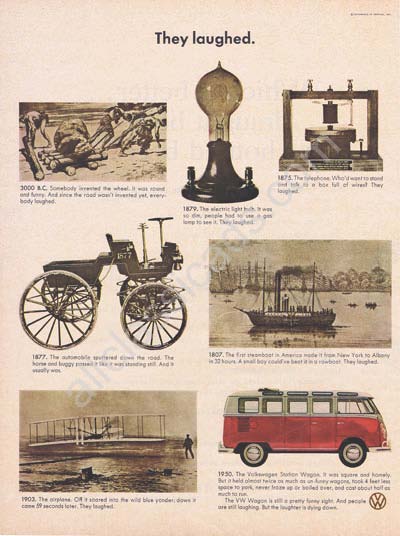 |
1950 VW Station Wagon
They laughed. 3000 B.C. Somebody invented the wheel. It was round and funny. And since the road wasn't invented yet, everybody laughed.
1879. The electric light bulb. It was so dim, people had to use a gas lamp to see it. They laughed.
1875. The telephone. Who'd want to stand and talk to a box full of wires? They laughed.
1877. The automobile sputtered down the road. The horse and buggy passed it like it was standing still. And it usually was.
1807. The first steamboat in America made it from New York to Albany in 32 hours. A small boy could've beat it in a rowboat. They laughed.
1903. The airplane. Off it soared into the wild blue yonder; down it came 59 seconds later. They laughed.
1950. The Volkswagen Station Wagon. It was square and homely. But it held almost twice as much as un-funny wagons, took 4 feet less space to park, never froze up or boiled over, and cost about half as
much to run.
The VW Wagon is still a pretty funny sight. And people are still laughing. But the laughter is dying down.
Size (10 1/4 X 13 5/8 INCHES) (26 X 34.6 CM)
Grading - Excellent
Availability - 1 in stock
Price - $40.00
Publishing Date: month unknown, 1950
Shipping and handling fees - verify postal code
Catalog ID: vw00001

|
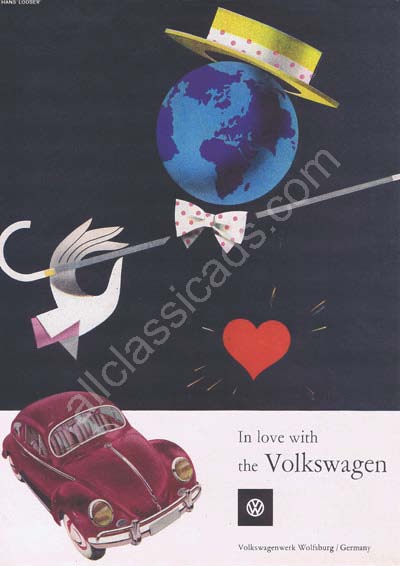 |
1956 Volkswagen Beetle
Description:
In Love with the Volkswagen
Size (7 7/8 X 11 1/8 INCHES) (20 X 28.3 CM)
Grading - Excellent
Availability - 1 in stock
Price - $40.00
Publishing Date: month unknown, 1950
Shipping and handling fees - verify postal code
Catalog ID: vw00028

|
 |
1958 Volkswagen Pick-up, Six-Passenger Pick-up, and Window Van
Description:
Which Volkswagen truck is best for your farm?
The VW Pick-up carries 1,674 lbs. payload on a 45-sq. ft. loading floor-plus a weathertight inside locker that provides 23 cu. ft. additional space. Sides can be lowered to convert it into a roomy flat-bed truck. Stakes and tarpaulin (optional at extra cost) make it a covered van.
The VW Six-Passenger Pick-up has 30-sq. ft. of load area, and room for six adults. Or with the passenger seat removed you can have a lockable, heated compartment for delicate produce or valuable equipment, and still have the pick-up at the rear. (Stakes and tarpaulin are available at extra cost.)
The VW Window Van is the ideal combination of cargo carrier and personnel carrier. It carries nine farm hands in ease and comfort. The two rear seats can be removed easily to give you a cargo carrier with 1,786 Ibs. capacity. With one seat removed, it carries, six people, plus 1,036 lbs.
No matter which VW truck you choose, you'll get more work done at holf the over-all cost of usual half-ton trucks. We'll gladly show you the figures. Just ask.
Size (6 1/4 X 14 3/4 INCHES) (15.9 X 37.5 CM)
Grading - Excellent
Availability - 1 in stock
Price - $40.00
Publishing Date: month unknown, 1958
Shipping and handling fees - verify postal code
Catalog ID: vw00023

|
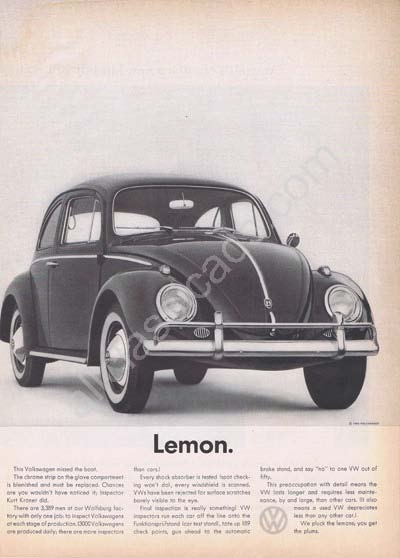 |
1960 Volkswagen Beetle
Description:
Lemon.
This Volkswagen missed the boat. The chrome strip on the glove compartment is blemished and must be replaced. Chances are you wouldn't have noticed it; Inspector Kurt Kroner did.\
There are 3,389 men at ou
Wolfsburg factory with only one job: to inspect Volkswagens at each stage of production. (3000 Volkswagens are produced daily; there are more inspectors than cars.) Every shock absorber is tested (spot checking won't do), every windshield is scanned. VWs have been rejected for surface scratches barely visible to the eye. Final inspection is really something! VW inspectors run each car off the line onto the Funktionsprufstand (car test stand), tote up 189 check points, gun ahead to the automatic brake stand, and say "no" to one VW out of fifty. This preoccupation with detail means the VW lasts longer and requires less maintenance, by and large, than other cars. (It also means a used VW depreciates less than any other car.) We pluck the lemons; you get the plums.
Size (10 X 14 INCHES) (25.4 X 35.6 CM)
Grading - Excellent
Availability - 1 in stock
Price - $30.00
Publishing Date: month unknown, 1958
Shipping and handling fees - verify postal code
Catalog ID: vw00024

|
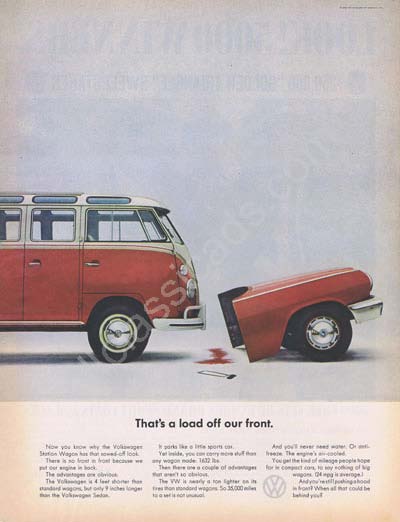 |
1963 Volkswagen Station Wagon
Description:
That's a load off our front.
Now you know why the Volkswagen Station Wagon has that sawed-off look. There is no front in front because we put our engine in back. The advantages are obvious: The Volkswagen is 4 feet shorter than standard wagons, but only 9 inches longer than the Volkswagen Sedan.
It parks like a little sports car. Yet inside, you can carry more stuff than any wagon made: 1632 lbs. Then there are a couple of advantages that aren't so obvious. The VW is nearly a ton lighter on its tires than standard wagons. So 35,000 miles to a set is not unusual.
And you'll never need water. Or anti freeze. The engine's air-cooled. You get the kind of mileage people hope for in compact cars, to say nothing of big wagons. (24 mpg is average.) And you're still pushing a hood in front? When all that could be behind you?
Size (10 1/2 X 13 5/8 INCHES) (26.7 X 34.6 CM)
Grading - Very Good (Staple rust on left side)
Availability - 1 in stock
Price - $30.00
Publishing Date: month unknown, 1963
Magazine: Life Magazine
Shipping and handling fees - verify postal code
Catalog ID: vw00025

|
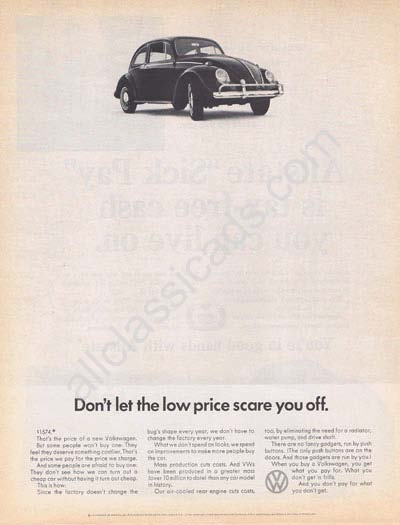 |
1966 Volkswagen Beetle
Description:
Don't let the low price scare you off.
$1574.*
That's the price of a new Volkswagen. But some people won't buy one: They feel they deserve something costlier. That's the price we pay for the price we charge.
And some people are afraid to buy one: They don't see how we can turn out a cheap car without having it turn out cheap. This is how: Since the factory doesn't change the bug's shape every year, we don't have to change the factory every year. What we don't spend on looks, we spend on improvements to make more people buy the car. Mass production cuts costs. And VWs have been produced in a greater mass (over 10 million to date) than any car model in history. Our air-cooled rear engine cuts costs, too, by eliminating the need for a radiator, water pump, and drive shaft. There are no fancy gadgets, run by push buttons. (The only push buttons are on the doors. And those gadgets are run by you.) When you buy a Volkswagen, you get what you pay for. What you don't get is frills. And you don't pay for what you don't get.
Size (10 1/8 X 13 1/4 INCHES) (25.7 X 33.7 CM)
Grading - Excellent
Availability - 1 in stock
Price - $30.00
Publishing Date: month unknown, 1966
Magazine: Life Magazine
Shipping and handling fees - verify postal code
Catalog ID: vw00027

|
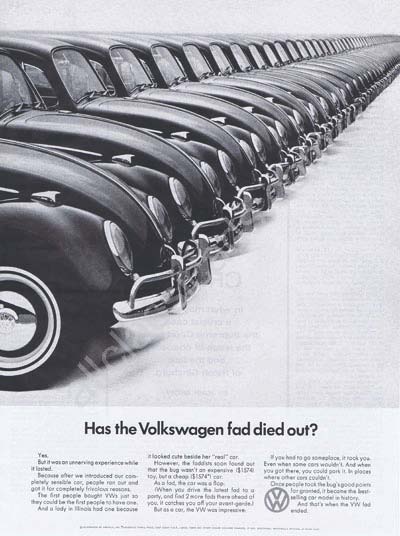

Buy at Etsy
1960 Volkswagen Ad Beetle Fad died out? Framed Poster 11" by 14"
https://oldclassicads.etsy.com/listing/1693933299
|
1966 Volkswagen Beetle
Description:
Has the Volkswagen fad died out?
Yes.
But it was an unnerving experience while it lasted. Because after we introduced our completely sensible car, people ran out and got it for completely frivolous reasons. The first people bought VWs just so they could be the fI rst people to have one. And a lady in Illinois had one because
it looked cute beside her "real" car. However, the faddists soon found out that the bug wasn't an expensive ($1574) toy, but a cheap ($1574*) car. As a fad, the car was a flop: (When you drive the latest fad to a party, and find 2 more fads there ahead of you, it catches you off your avant-garde.) But as a car, the VW was impressive:
If you had to go someplace, it took you. Even when some cars wouldn't. And when you got there, you could park it. In places where other cars couldn't. Once people took the bug's good points for granted, it became the bestselling car model in history. And that's when the VW fad ended.
Size (10 1/8 X 13 1/2 INCHES) (25.7 X 34.3 CM)
Grading - Excellent
Availability - 1 in stock
Price - $30.00
Publishing Date: month unknown, 1966
Magazine: Life Magazine
Shipping and handling fees - verify postal code
Catalog ID: vw00022

|
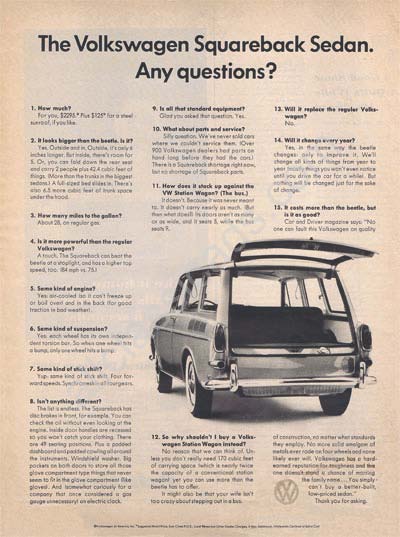 |
1966 Volkswagen Squareback Sedan
The Volkswagen Squareback Sedan.
Any questions?
1. How much?
For you, $2295.* Plus $125* for a steel . sunroof, if you like.
2. It looks bigger than the beetle. Is it?
Yes. Outside and in. Outside, it's only 6 inches longer. But inside, there's room for
5. Or, you can fold down the rear seat and carry 2 people plus 42.4 cubic feet of things. (More than the trunks in the biggest sedans. A full-sized bed slides in. There's also 6.5 more cubic feet of trunk space under the hood.
3. How many miles to the gallon?
About 28, on regular gas.
4. Is it more powerful than the regular Volkswagen?
A touch. The Squareback can beat the beetle at a stoplight, and has a higher top speed, too. (84 mph vs. 75.)
5. Same kind of engine?
Yes: air-cooled (so it can't freeze up or boil over) and in the back (for good traction in bad weather).
Size (10 1/4 X 13 3/4 INCHES) (26 X 34.9 CM)
Grading - Good (Water stains on bottom right and left)
Availability - 1 in stock
Price - $20.00
Publishing Date: month unknown, 1966
Magazine: Life Magazine
Shipping and handling fees - verify postal code
Catalog ID: vw00003

|
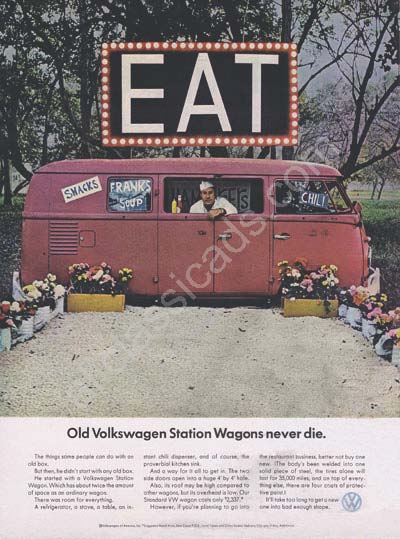 |
1966 Volkswagen Station Wagon
Old Volkswagen Station Wagons never die.
The things some people can do with an old box. But then, he didn't start with any old box. He started with a Volkswagen Station Wagon. Which has about twice the amount of space as an ordinary wagon. There was room for everything. A refrigerator, a stove, a table, an instant chili dispenser, and of course, the proverbial kitchen sink. And a way for it all to get in. The two side doors open into a huge 4' by 4' hole. Also, its roof may be high compared to other wagons, but its overhead is low. Our Standard VW wagon costs only $2,337.*
However, if you're planning to go into the restaurant business, better not buy one
new. (The body's been welded into one solid piece of steel, the tires alone will last for 35,000 miles, and on top of everything else, there are four coats of protective paint.) It'll take too long to get a new one into bad enough shape.
Size (10 1/4 X 13 5/8 INCHES) (26 X 34.6 CM)
Grading - (Some pretty bad discoloration on bottom + a bit on photo)
Availability - 1 in stock
Price - $20.00
Publishing Date: month unknown, 1966
Magazine: Life Magazine
Shipping and handling fees - verify postal code
Catalog ID: vw00026

|
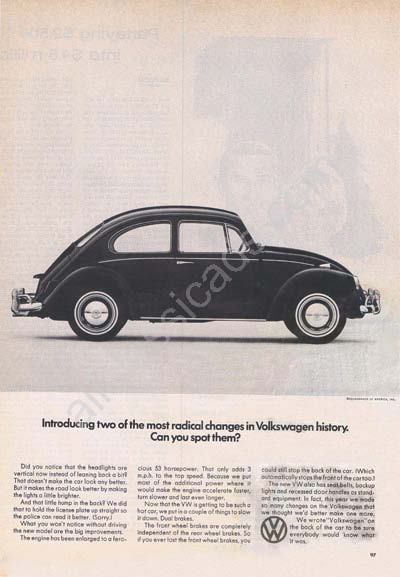 |
1967 Volkswagen Beetle
Introducing two of the most radical changes in Volkswagen history. Can you spot them?
Did you notice that the headlights are vertical now instead of leaning back a bit?
That doesn't make the car look any better. But it makes the road look better by making the lights a little brighter. And that little hump in the back? We did that to hold the license plate up straight so the police can read it better. (Sorry.) What you won't notice without driving the new model are the big improvements. The engine has been enlarged to a ferocious 53 horsepower. That only adds 3 m.p.h. to the top speed. Because we put most of the additional power where it would make the engine accelerate faster, turn slower and last even longer. Now that the VW is getting to be such a hot car, we put in a couple of things to slow it down. Dual brakes. The front wheel brakes are completely independent of the rear wheel brakes. So if you ever lost the front wheel brakes,.you could still stop the back of the car. (Which automatically stops the front of the cartoo.)
The new VW also has seat belts, backup lights and recessed door handles as standard equipment. In fact, this year we made so many changes on the Volkswagen that we thought we'd better make one more. We wrote."Volkswagen"on the back of the car to be sure everybody would know what
it was.
Size (9 3/8 X 13 5/8 INCHES) (23.8 X 34.6 CM)
Grading - Poor (Bad Water/Discoloration on bottom right)
Availability - 1 in stock
Price - $20.00
Publishing Date: month unknown, 1966
Magazine: Life Magazine
Shipping and handling fees - verify postal code
Catalog ID: vw00016

|
 |
1967 Volkswagen Beetle
We made the car
go faster.
And the engine
go slower.
We've added a full 3 m.p.h. to the top speed of the Volkswagen. If that doesn't sound like a lot to you, it's because it isn't. And wasn't meant to be. We put most of the power increase (from 50 horsepower to 53) into the lower gears. So you could climb hills easier. And accelerate quicker.
But we didn't do all this at the expense of the engine. In fact, we made the engine turn even slower. So it would last even longer. You'll be very happy to know this speedy new Volkswagen has dual brakes as standard equipment. If the front brakes should ever fail, the rear brakes will stop you. And vice versa. We even put in some changes you can see, like retracting seat belts, recessed inside
door handles, and back up lights. They're standard, too. And so are the letters V-O-L-K-S-W-A-G-E-N on the engine lid. So you'll recognize the new bug when it passes you. With its new, slower engine.
Size (10 3/8 X 13 5/8 INCHES) (26.4 X 34.6 CM)
Grading - Excellent
Availability - 1 in stock
Price - $30.00
Publishing Date: month unknown, 1967
Magazine: Life Magazine
Shipping and handling fees - verify postal code
Catalog ID: vw00020

|
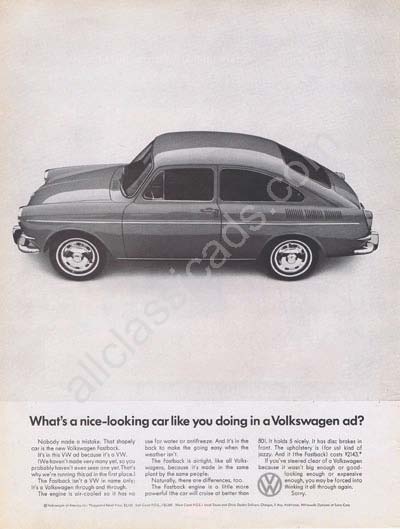 |
1967 Volkswagen Fastback
What's a nice-looking car like you doing in a Volkswagen ad?
Nobody made a mistake. That shapely car is the new Volkswagen Fastback. It's in this VW ad because it's a VW. (We haven't made very many yet, so you probably haven't even seen one yet. That's why we're running this ad in the first place.) The Fastback isn 't a VW in name only; it's a Volkswagen through and through. The engine is air-cooled so it has no use for water or antifreeze. And it's in the back to make the going easy when the weather isn't.
The Fastback is airtight, like all Volkswagens, because it's made in the same plant by the same people. Naturally, there are differences, too. The Fastback engine is a little more powerful (the car will cruise at better than 80). It holds 5 nicely. It has disc brakes in front.
The upholstery is (for us) kind of jazzy. And it (the Fastback) costs $2143.* If you've steered clear of a Volkswagen because it wasn't big enough or good- looking enough or expensive enough, you may be forced into thinking it all through again. Sorry.
Size (10 3/8 X 13 5/8 INCHES) (26.4 X 34.6 CM)
Grading - Excellent
Availability - 1 in stock
Price - $30.00
Publishing Date: month unknown, 1967
Magazine: Life Magazine
Shipping and handling fees - verify postal code
Catalog ID: vw00020

|
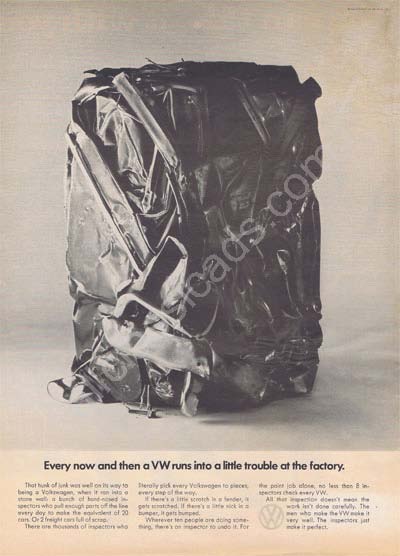 |
1967 Volkswagen Quality Assurance
Every now and then a VW runs into a little trouble at the factory.
That hunk of junk was well on its way to being a Volkswagen, when it ran into a stone wall: a bunch of hard-nosed inspectors who pull enough parts off the line every day to make the equivalent of 20 cars. Or 2 freight cars full of scrap. There are thousands of inspectors who literally pick every Volkswagen to pieces, every step of the way. If there's a little scratch in a fender, it gets scratched. If there 's a little nick in a bumper, it gets bumped. Wherever ten people are doing something, there 's an inspector to undo it. For the paint job alone, no less than 8 inspectors check every VW.
All that inspection doesn't mean the work isn't done carefully. The men who make the VW make it very well. The inspectors just make it perfect.
Size (10 1/4 X 13 5/8 INCHES) (26 X 34.6 CM)
Grading - Excellent
Availability - 1 in stock
Price - $20.00
Publishing Date: month unknown, 1967
Magazine: Unknown
Shipping and handling fees - verify postal code
Catalog ID: vw00018

|
 |
1967 Volkswagen Squareback Sedan
It may be less grand than most station wagons.
But it's also about a grand less.
If you're looking for a miniature moving van, our Squareback Sedan isn't it. Even with its back seat folded down it only holds half as much as the average station wagon. Which means you can't lug 30 pieces of luggage. Or a full-sized double bed. But maybe you just need a car that can carry 15 valises. Or a full-sized single bed. Then you can save a lot of money with a Squareback Sedan.
It costs only $2295.*
And it not only goes for less than most conventional wagons to begin with, it keeps on going for less. A Squareback travels about 27 miles on a gallon of gas. It takes 5 pints of oil instead of 5 quarts. It never needs an ounce of antifreeze, because it's cooled by air. It should get a good 35,000 miles on a set of tires. And it avoids repair bills like a ... well, like a Volkswagen. So before you go out and buy some station wagon that has twice as much space as you really need, ask yourself this question: Will all that extra grandness be worth an extra grand?
Size (10 1/4 X 13 5/8 INCHES) (26 X 34.6 CM)
Grading - Good (Crease and water stains on left)
Availability - 1 in stock
Price - $20.00
Publishing Date: month unknown, 1967
Magazine: Unknown
Shipping and handling fees - verify postal code
Catalog ID: vw00019

|

Click on image to enlarge |
1967 Volkswagen Station Wagon
How many mistakes can you spot in this picture?
Score 10 for each mistake you find. 80 is a perfect score. (Absolutely no credit for saying the whole wagon looks like a mistake.) THE FRONT OF A VOLKSWAGEN STATION WAGON DOESN'T OPEN UP. No need. To get to the engine, which is in the rear, you just flip up a flap in the rear. And since there's no engine sticking out in front, it can't get in the way when you're parking. DOESN'T USE EIGHT SPARK PLUGS. Only four. So whatever a spark plug costs you'll save four times that much when it's time for a tune-up.
NO WATER. Our engine cools itself with air. Air won't freeze up or boil over on you. And you'll never have to check to see if you have enough air. NO ANTI-FREEZE. No place to pour it.
TAKES JUST 2 1/2 QUARTS OF OIL. That's about 2 1/2 quarts less than most wagons take. LUGGAGE RACK. The chances are if you buy a luggage rack, the only thing you'll end up with on your roof is a luggage rack. Because a Volkswagen
Station Wagon can' carry about twice as much as other wagons can, inside. That's
170 cubic feet of space to be exact. CHAINS. The weight of our rear engine on the rear wheels gives them extra traction. So you may need chains, but not as soon or as often. And finally:
THE MECHANIC FIXING THE VOLKSWAGEN STATION WAGON IS NOT AN AUTHORIZED VOLKSWAGEN MECHANIC. Which is probably the first mistake.
Size (20 5/8 X 13 3/4 INCHES) (52.4 X 34.9 CM)
Grading - Good (Staple rust)
Availability - 1 in stock
Price - $20.00
Publishing Date: Month unknown, 1967
Shipping and handling fees - verify postal code
Catalog ID: ford00067

|
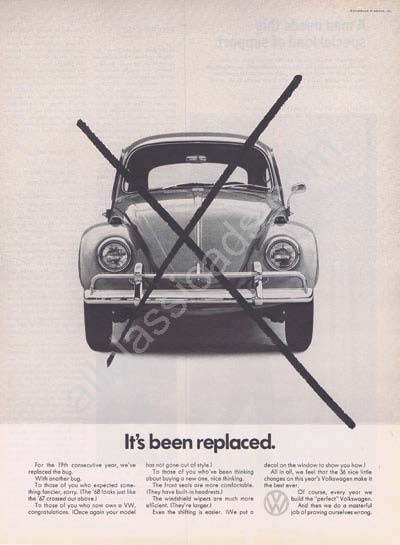 |
1968 Volkswagen Beetle
Its been replaced.
For the 19th consecutive year, we've replaced the bug. With another bug. To those of you who expected something fancier, sorry. (The '68 looks just like the '67 crossed out above.) To those of you who now own a VW, congratulations. (Once again your model has not gone out of style.) To those of you who've been thinking about buying a new one, nice thinking.
The front seats are more comfortable. (They have built-in headrests.) The windshield wipers are much more efficient. (They're larger.) Even the shifting is easier. (We put a decal on the window to show you how.)
All in all, we feel that the 36 nice little changes on this year's Volkswagen make it the best ever. Of course, every year we build the "perfect" Volkswagen. And then we do a masterful job of proving ourselves wrong.
Size (10 1/8 X 13 5/8 INCHES) (25.7 X 34.6 CM)
Grading - Excellent
Availability - 1 in stock
Price - $20.00
Publishing Date: month unknown, 1968
Magazine: Unknown
Shipping and handling fees - verify postal code
Catalog ID: vw00015

|
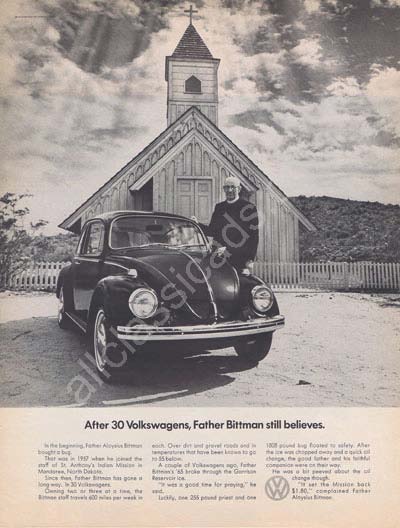 |
1969 Volkswagen Beetle
After 30 Volkswagens, Father Bittman still believes.
In the beginning, Father Aloysius Bittman bought a bug. That was in 1957 when he joined the staff of St. Anthony's Indian Mission in Mandaree, North Dakota. Since then, Father Bittman has gone a long way. In 30 Volkswagens. Owning two or three at a time, the Bittman staff travels 600 miles per week in each.
Over dirt and gravel roads and in temperatures that have been known to go to 55 below. A couple of Volkswagens ago, Father Bittman's '65 broke through the Garrison Reservoir ice. "It was a good time for praying," he said. Luckily, one 255 pound priest and one
1808 pound bug floated to safety. After the ice was chopped away and a quick oil change, the good father and his faithful companion were on their way. He was a bit peeved about the oil change though. "It set the Mission back $1.80," complained Father Aloysius Bittman.
Size (10 3/8 X 13 5/8 INCHES) (26.4 X 34.6 CM)
Grading - Excellent
Availability - 1 in stock
Price - $20.00
Publishing Date: month unknown, 1969
Magazine: Unknown
Shipping and handling fees - verify postal code
Catalog ID: vw00014

|
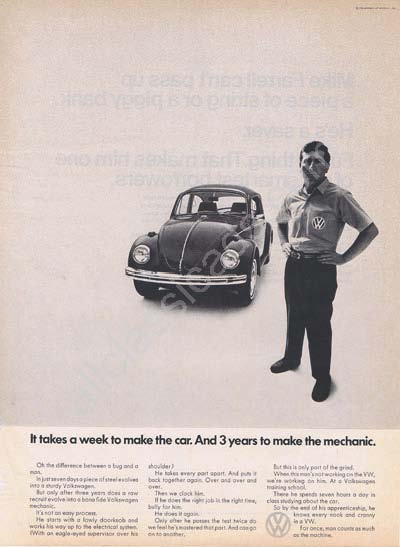 |
1969 Volkswagen Beetle
It takes a week to make the car. And 3 years to make the mechanic.
Oh the difference between a bug and a man. In just seven days a piece of steel evolves into a sturdy Volkswagen. But only after three years does a raw recruit evolve into a bona fide Volkswagen mechanic. It's not an easy process. He starts with a lowly doorknob and works his way up to the electrical system. (With an eagle-eyed supervisor over his shoulder.) He takes every part apart. And puts it back together again. Over and over and over. Then we clock him. If he does the right job in the right time, bully for him. He does it again. Only after he passes the test twice do we feel he's mastered that part. And can go on to another.
But this is only part of the grind. When this man's not working on the VW, we're working on him. At a Volkswagen
training school. There he spends seven hours a day in class studying about the car. So by the end of his apprenticeship, he knows every nook and cranny in a VW. For once, man counts as much as the machine.
Size (10 1/8 X 13 5/8 INCHES) (25.7 X 34.6 CM)
Grading - Very Good (Little discoloration left bottom side, frame wll cover it)
Availability - 1 in stock
Price - $20.00
Publishing Date: month unknown, 1969
Magazine: Unknown
Shipping and handling fees - verify postal code
Catalog ID: vw00012

|
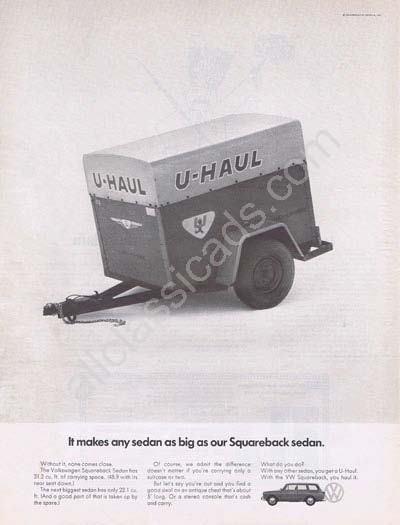 |
1969 Volkswagen Squareback Sedan
It makes any sedan as big as our Squareback sedan.
Without it, none comes close. The Volkswagen Squareback Sedan has 31.2 cu. ft. of carrying space. (48.9 with its rear seat down.) The next biggest sedan has only 22.1 cu. ft. (And a good part of that is taken up by the spare.)
Of course, we admit the difference doesn't matter if you're carrying only a suitcase or two. But let's say you're out and you find a good deal on an antique chest that's about 5' long. Or a stereo console that's cash and carry.
What do you do? With any other sedan, you get U-Haul. With the VW Squareback, you haul it.
Size (10 3/8 X 13 5/8 INCHES) (26.4 X 34.6 CM)
Grading - (Faint discoloration bottom left)
Availability - 1 in stock
Price - $20.00
Publishing Date: month unknown, 1969
Magazine: Life Magazine
Shipping and handling fees - verify postal code
Catalog ID: vw00013

|
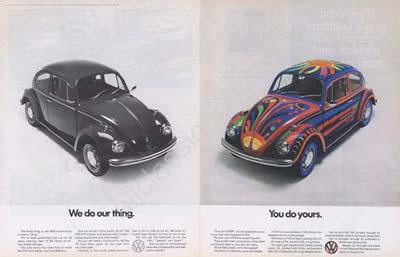
Click on image to enlarge |
1970 Volkswagen Beetle
We do our thing.
The funny thing is, we didn't even know we had a "thing". We've been perfecting one car for 25 years, steering clear of the idiocy of annual model changes. Our only worry has been how to make the VW work better, not look different.
And we haven't done badly at all: The 1970 VW is faster and quieter with a longerlasting engine than any other beetle. But you still need a scorecard to tell the '70 from other years. Or any year from any other year. Nobody in the world makes and services a car as well as we do. Because nobody's been doing it as long on one model. We still use old-fashioned words like "nifty," "peachy" and "swell". And we stick to old-fashioned ideas like craftsmanship and dedication and skill.
You do yours.
Then, for $1839*, our thing becomes your thing. And what happens is wild. People treat VWs like something else. They polish them, scrub them, stripe them and flower them in very far-out ways. Why? Why mostly on Volkswagens? We think it's affection, pure and simple.
Size (20 5/8 X 13 1/4 INCHES) (52.4 X 33.7 CM)
Grading - Very Good (Brown spot of some sort, or else perfect)
Availability - 1 in stock
Price - $30.00
Publishing Date: Month unknown, 1970
Magazine: Life Magazine
Shipping and handling fees - verify postal code
Catalog ID: ford00009

|
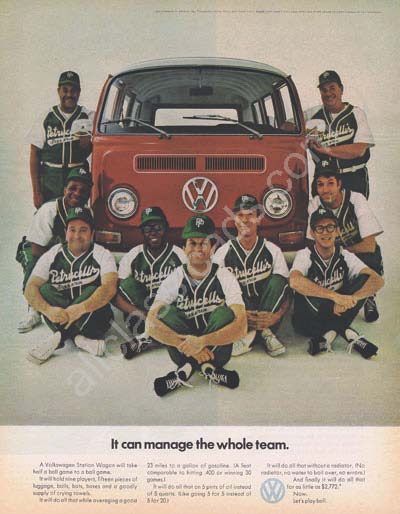 |
1970 Volkswagen Station Wagon
It can manage the whole team.
A Volkswagen Station Wagon will take half a ball game to a ball game. It will hold nine players, fifteen pieces of luggage, balls, bats, bases and a goodly supply of crying towels. It will do all that while averaging a good 23 miles to a gallon of gasoline. (A feat comparable to hitting .400 or winning 30 games.) It will do all that on 5 pints of oil instead of 5 quarts. (Like going 5 for 5 instead of 5 for 20.)
It will do all that without a radiator. (No radiator, no water to boil over, no errors.) And finally it will do all that for as little as $2,772.* - Now.
Let's play ball.
Size (10 1/4 X 13 1/4 INCHES) (26 X 33.7 CM)
Grading - Excellent
Availability - 1 in stock
Price - $20.00
Publishing Date: month unknown, 1970
Magazine: Unknown
Shipping and handling fees - verify postal code
Catalog ID: vw00010

|
 |
1970 Volkswagen Station Wagon
Funny comparison ad
The only thing that looks funnier than a Volkswagen carrying 176 cubic feet of things is someone else's wagon carrying 176 cubic feet of things.
Size (10 1/4 X 13 1/4 INCHES) (52.4 X 33.7 CM)
Grading - Excellent
Availability - 1 in stock
Price - $20.00
Publishing Date: month unknown, 1970
Magazine: Unknown
Shipping and handling fees - verify postal code
Catalog ID: vw00011

|
 |
1971 Volkswagen Beetle
Two ridiculous gimmicks of the 1940's.
Everyone laughed when they came out with the television. A box that could show pictures from 3,000 miles away? Absurd. But everyone really cracked up when we came out with the Volkswagen. A car with its engine in the back? Its trunk in tne front? And its radiator in neither the front nor the back?
It even looked like a joke. But time marched on. The television clicked. The Volkswagen accelerated. People liked the idea of a car that didn't drink gas like water. Or oil like,water. Or, for that matter, didn't, even drink waterSome strange people even liked the idea that it was strange looking.
In fact, Detroit car makers now like the idea of the VW so much that they have decided to make their own. But even with all those new small cars ground, the fate of the bug is still secure. This is the first year for all of the others. We've had twenty-three years of re-runs.
Size (10 1/4 X 13 1/4 INCHES) (26 X 33.7 CM)
Grading - Excellent
Availability - 1 in stock
Price - $20.00
Publishing Date: month unknown, 1971
Magazine: Unknown
Shipping and handling fees - verify postal code
Catalog ID: vw00006

|
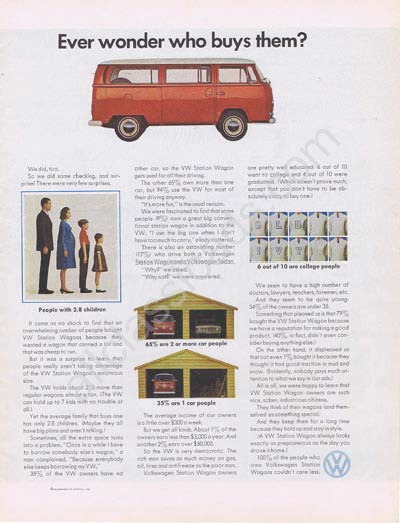 |
1971 Volkswagen Station Wagon
Ever wonder who buys them?
Size (10 1/4 X 13 1/4 INCHES) (26 X 33.7 CM) & (8 1/2 X 12 1/2 INCHES) (21.6 X 31.8 CM)
Grading - Excellent, Poor, & Poor (Bad Discoloration)
Availability - Two & One (Three in all, two with first parameter, one with second)
Price - $20.00
Publishing Date: month unknown, 1971
Magazine: Unknown
Shipping and handling fees - verify postal code
Catalog ID: vw00008

|
 |
1972 Volkswagen Beetle
Why a $2000.00 Volkswagen costs a lot less than any other $2000.00 car.
Why a $2,000 Volkswagen* costs a lot less than any other $2,000 car.
Listen to the logic:
Give or toke a few dollars, most new economy cars are priced just about the some these days.
Around $2,000. But when you sell it, a weird thing happens. Some are worth more to you than others. And based on what's happened in the past, after 3 or 4 years, not one is worth more cash than you-know-who:
The Volkswagen Beetle: So the real price you pay for a car is the difference between what you pay now and what you get back later, when you sell it. Anyhow, take a good look at the chart on the right. It'll give you an idea of the overage retail depreciation of some famous 1969 economy cars. Based on prices they were sold for by Used car Dealers in Jon., 1972.
Remember, it's one thing to say today "I just bought the lowest priced car in town." It's another thing tomorrow to say "I just sold the lowest-priced car. In town."
Size (10 1/8 X 13 1/8 INCHES) (25.7 X 33.3 CM)
Grading - Excellent
Availability - 1
Price - $20.00
Publishing Date: month unknown, 1971
Magazine: Unknown
Shipping and handling fees - verify postal code
Catalog ID: vw00007

|
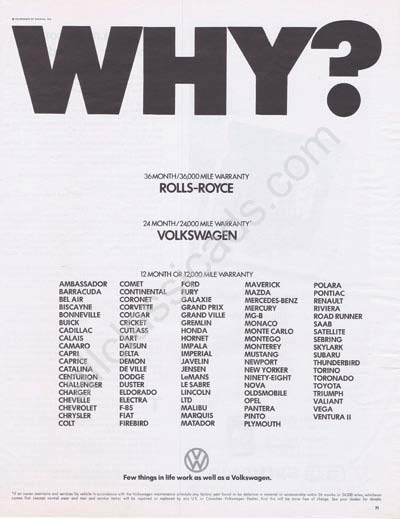 |
1972 Volkswagen Why? Advertisement
WHY?
36 MONTH /36,000 MILE WARRANTY ROLLS-ROYCE
24 MONTH 124,000 MILE WARRANTY' VOLKSWAGEN
12 MONTH OR 12,000 MILE WARRANTY AMBASSADOR, COMET FORD, MAVERICK, POLARA, BARRACUDA, CONTINENTAL, FURY, MAZDA, PONTIAC, BELAIR, CORONET, GALAXIE, MERCEDES·BENZ, RENAULT, BISCAYNE, CORVETTE, GRAND, PRIX, MERCURY, RIVIERA, BONNEVILLE, COUGAR, GRANDVILLE, MG·B, ROADRUNNER, BUICK, CRICKET, GREMLIN, MONACO, SAAB, CADILLAC, CUTLASS, HONDA, MONTE CARLO, SATELLITE, CALAIS, DART, HORNET, MONTEGO, SEBRING, CAMARO, DATSUN, IMPALA, MONTEREY, SKYLARK, CAPRI, DELTA, IMPERIAL, MUSTANG, SUBARU, CAPRICE, DEMON, JAVELIN, NEWPORT, THUNDERBIRD, CATALINA, DE VILLE, JENSEN, NEW YORKER, TORINO, CENTURION, DODGE, LeMANS, NINETY·EIGHT, TORONADO, CHALLENGER, DUSTER, LESABRE, NOVA, TOYOTA, CHARGER, ELDORADO, LINCOLN, OLDSMOBILE, TRIUMPH, CHEVELLE, ELECTRA, LTD, OPEL, VALIANT, CHEVROLET, F·SS, MALIBU, PANTERA, VEGA, CHRYSLER, FIAT, MARQUIS, PINTO, VENTURA II, COLT, FIREBIRD, MATADOR, PLYMOUTH.
Few things in life work as well as a Volkswagen.
Size (10 1/4 X 13 1/4 INCHES) (26 X 33.7 CM)
Grading - Excellent
Availability - 2
Price - $20.00
Publishing Date: month unknown, 1972
Magazine: Unknown
Shipping and handling fees - verify postal code
Catalog ID: vw00004

|
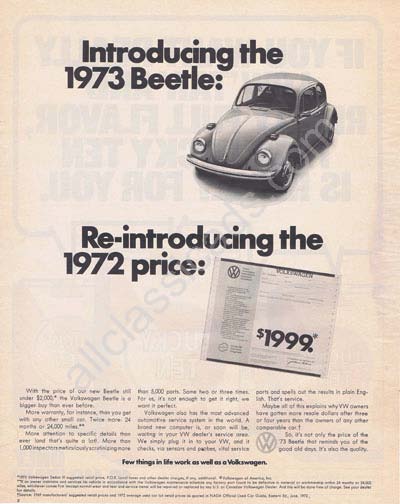 |
1973 Volkswagen Beetle
Introducing the 1973 Beetle:
Re-Introducing the 1972 Price: 1999.
With the price of our new Beetle still under $2,000,* the Volkswagen Beetle is a bigger buy than ever before. More warranty, for instance, than you get with any other small car. Twice more: 24 months or 24,000 miles. ** More attention to specific details than ever (and that's quite a lot). More than 1,000 inspectors meticulously scrutinizing more than 5,000 parts. Some two or three times., For us, it's not enough to get it right, we want it perfect. Volkswagen also has the most advanced automotive service system in the world, A brand new computer is, or soon will be, waiting in your VW dealer's service area. We simply plug it in to your VW, and it checks, via sensors and preobes, vital service parts and spells out the results in plain English. That's service. Maybe all of this explains whyVW owners have gotten more resale dollars after three or four years than the owners of any other comparable car. So, it's not only the price of the '73 Beetle that reminds you of the good old days. It's also the quality.
Few things in life work as well as a Volkswagen.
Size (8 X 11 1/8 INCHES) (20.3 X 28.3 CM) & (10 1/4 X 12 7/8 INCHES) (26 X 32.7 CM)
Grading - Excellent
Availability - 2
Price - $20.00
Publishing Date: month unknown, 1973
Magazine: Playboy
Shipping and handling fees - verify postal code
Catalog ID: vw00005

|
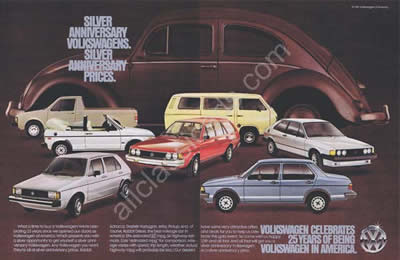
Click on image to enlarge |
1981 Volkswagen Rabbit, Scirocco, Dasher, Vanagon, Jetta, Pickup, and Rabbit Diesel
Silver Anniversary Volkswagens. Silver Anniversary Prices.
What a time to buy a Volkswagen! We're celebrating 25 years since we opened our doors as Volkswagen of America. Which pressents you with a silver opportunity to get yourself a silver anniversary Volkswagen. Any Volkswagen you want. They're all at silver anniversary prices. Rabbit. Scirocco. Dasher. Vanagon. Jetta. Pickup. And, of course, Rabbit Diesel, the best-mileage car in America. EPA estimated 42 mpg, 56 highway estimate. (Use "estimated mpg" for comparison. Mileage varies with speed, trip length, weather. Actual Highway mpg will probably be less.) Our dealers have some very attractive offers and deals for you to help us celebrate this gala event. So come wish us happy 25th and all that. And all that will get you a silver anniversary Volkswagen. At a silver anniversary price.
Volkwagen Celebrates 25 Years Of Being Volkswagen In America.
Size (20 1/8 X 13 INCHES) (51.1 X 33 CM)
Grading - Excellent
Availability - 1 in stock
Price - $30.00
Publishing Date: Month unknown, 1970
Magazine: Life Magazine
Shipping and handling fees - verify postal code
Catalog ID: ford00002

|
|
|



